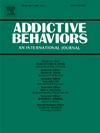Longitudinal analysis of predictors of electronic cigarette trial among adolescents in Guatemala
IF 3.7
2区 医学
Q1 PSYCHOLOGY, CLINICAL
引用次数: 0
Abstract
Background: Understanding factors influencing electronic cigarette (e-cigarette) trial in adolescents is crucial for shaping policies and interventions to reduce consumption and potentially prevent addictive tendencies, particularly in countries with weak regulations like Guatemala. Objective: We aimed to longitudinally assess predictors of e-cigarette trial among Guatemalan adolescents surveyed in 2019, 2020, and 2021. Methods: Students (13 to 18 years old) from nine private schools completed self-administered questionnaires about e-cigarette use and associated risk factors. Data from those who had at least one follow-up survey after reporting that they had never tried e-cigarettes at either the 2019 or 2020 survey (N = 838) was analyzed. We used a mixed-effects logistic regression clustered by student and school to assess predictors of ever e-cigarette use. Results: Nearly one-quarter (21.0 %) of unique students tried e-cigarettes at follow-up. Risk factors for e-cigarette trial included cigarette or heated tobacco products use (adjusted odds ratio [AOR] = 2.95, 95 %CI = 1.24–7.04), frequent exposure to online e-cigarette marketing (AOR = 2.46, 95 %CI = 1.39–4.35), alcohol or marihuana use (AOR = 1.74, 95 %CI = 1.17–2.58), and parental approval of e-cigarette use (AOR = 1.65, 95 %CI = 1.14–2.40). The perception that serious illness from life-long e-cigarette use is likely or certain (AOR = 0.57, 95 %CI = 0.36–0.91, and AOR = 0.37, 95 %CI = 0.19–0.72, respectively) appeared as a protective factor for e-cigarette trial. Conclusion: Our findings align with international research, indicating shared risk factors across youth worldwide. The incorporation of these factors into policies and interventions targeting the reduction of e-cigarette trial is imperative for optimizing their efficacy.
危地马拉青少年电子烟试验预测因素的纵向分析。
背景:了解影响青少年电子烟试验的因素对于制定政策和干预措施以减少消费并可能预防成瘾趋势至关重要,特别是在危地马拉等监管薄弱的国家。目的:我们旨在纵向评估2019年、2020年和2021年调查的危地马拉青少年中电子烟试验的预测因素。方法:来自9所私立学校的学生(13 - 18岁)完成了关于电子烟使用和相关危险因素的自我管理问卷。研究人员分析了那些在2019年或2020年的调查中报告从未尝试过电子烟的人(N = 838)的数据,这些人至少接受了一次后续调查。我们使用学生和学校聚类的混合效应逻辑回归来评估电子烟使用的预测因素。结果:近四分之一(21.0%)的独特学生在随访中尝试过电子烟。电子烟试验的危险因素包括香烟或加热烟草制品的使用(调整后的优势比[AOR] = 2.95, 95% CI = 1.24-7.04),频繁接触在线电子烟营销(AOR = 2.46, 95% CI = 1.39-4.35),酒精或大麻的使用(AOR = 1.74, 95% CI = 1.17-2.58),以及父母对电子烟使用的认可(AOR = 1.65, 95% CI = 1.14-2.40)。终身使用电子烟可能或肯定会导致严重疾病(AOR = 0.57, 95% CI = 0.36-0.91, AOR = 0.37, 95% CI = 0.19-0.72)是电子烟试验的保护因素。结论:我们的研究结果与国际研究一致,表明了全球青少年共有的风险因素。将这些因素纳入旨在减少电子烟试验的政策和干预措施中,对于优化其功效至关重要。
本文章由计算机程序翻译,如有差异,请以英文原文为准。
求助全文
约1分钟内获得全文
求助全文
来源期刊

Addictive behaviors
医学-药物滥用
CiteScore
8.40
自引率
4.50%
发文量
283
审稿时长
46 days
期刊介绍:
Addictive Behaviors is an international peer-reviewed journal publishing high quality human research on addictive behaviors and disorders since 1975. The journal accepts submissions of full-length papers and short communications on substance-related addictions such as the abuse of alcohol, drugs and nicotine, and behavioral addictions involving gambling and technology. We primarily publish behavioral and psychosocial research but our articles span the fields of psychology, sociology, psychiatry, epidemiology, social policy, medicine, pharmacology and neuroscience. While theoretical orientations are diverse, the emphasis of the journal is primarily empirical. That is, sound experimental design combined with valid, reliable assessment and evaluation procedures are a requisite for acceptance. However, innovative and empirically oriented case studies that might encourage new lines of inquiry are accepted as well. Studies that clearly contribute to current knowledge of etiology, prevention, social policy or treatment are given priority. Scholarly commentaries on topical issues, systematic reviews, and mini reviews are encouraged. We especially welcome multimedia papers that incorporate video or audio components to better display methodology or findings.
Studies can also be submitted to Addictive Behaviors? companion title, the open access journal Addictive Behaviors Reports, which has a particular interest in ''non-traditional'', innovative and empirically-oriented research such as negative/null data papers, replication studies, case reports on novel treatments, and cross-cultural research.
 求助内容:
求助内容: 应助结果提醒方式:
应助结果提醒方式:


